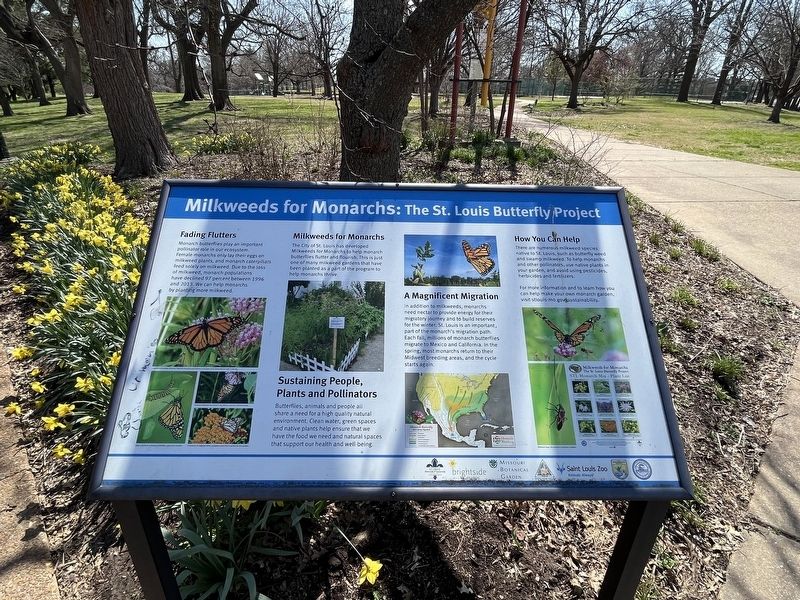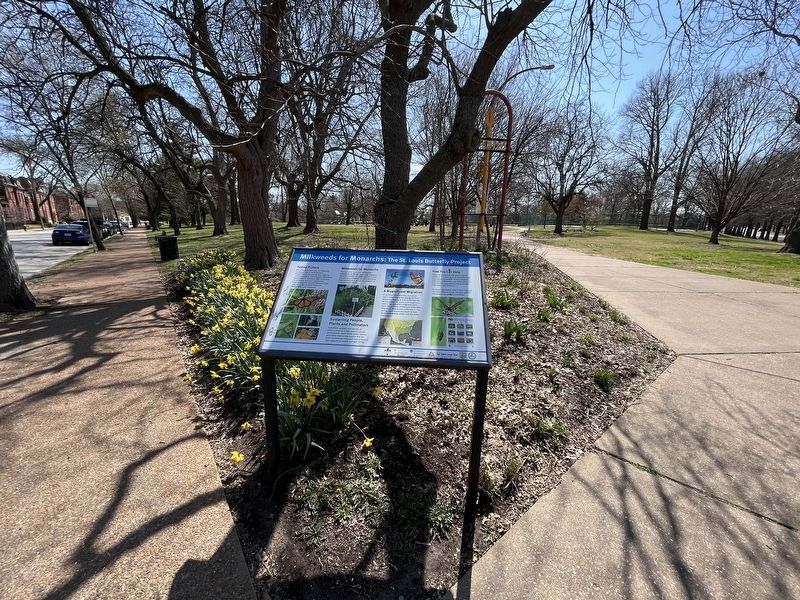Benton Park in St. Louis, Missouri — The American Midwest (Upper Plains)
Milkweeds for Monarchs: Th St. Louis Butterfly Project

By Devry Becker Jones (CC0), March 26, 2023
1. Milkweeds for Monarchs: Th St. Louis Butterfly Project Marker
Fading Flutters
Monarch butterflies play an important pollinator role in our ecosystem. Female monarchs only lay their eggs on milkweed plants, and monarch caterpillars feed solely on milkweed. Due to the loss of milkweed, monarch populations have declined 97 percent between 1996 and 2013. We can help monarchs by planting more milkweed.
Milkweeds for Monarchs
The City of St. Louis has developed Milkweeds for Monarchs to help monarch butterflies flutter and flourish. This is just one of many milkweed gardens that have been planted as part of the program to help monarchs thrive.
Sustaining People, Plants and Pollinators
Butterflies, animals and people all share a need for a high quality natural environment. Clean water, green spaces and native plants help ensure that we have the food we need and natural spaces that support our health and well-being.
A Magnificent Migration
In addition to milkweeds, monarchs need nectar to provide energy for their migratory journey and to build reserves for the winter. St. Louis is an important part of the monarch's migration path. Each fall, millions of monarch butterflies migrate to Mexico and California. In the spring, most monarchs return to their Midwest breeding areas, and the cycle starts again.
How You Can Help
There are numerous milkweed species native to St. Louis, such as butterfly weed and swamp milkweed. To help monarchs and other pollinators, use native plants in your garden, and avoid using pesticides, herbicides and fertilizers.
For more information and to learn how you can help make your own monarch garden, visit stlouis-mo.gov/sustainability.
Erected by City of St. Louis; Brightside St. Louis; Missouri Botanical Garden; St. Louis Zoo; Fish & Wildlife Service, U.S. Department of the Interior.
Topics. This historical marker is listed in these topic lists: Animals • Environment • Horticulture & Forestry • Parks & Recreational Areas. A significant historical year for this entry is 1996.
Location. 38° 35.926′ N, 90° 13.445′ W. Marker is in St. Louis, Missouri. It is in Benton Park. Marker is at the intersection of Arsenal Street and Jefferson Avenue on Arsenal Street. Touch for map. Marker is at or near this postal address: 2321 Arsenal St, Saint Louis MO 63118, United States of America. Touch for directions.
Other nearby markers. At least 8 other markers are within walking distance of this marker. Friedrich Hecker (approx. 0.2 miles away); If These Walls Could Talk? They Can. (approx. 0.4 miles away); The First Nickelodeon (approx. 0.4 miles away); 2315-17 Cherokee (approx. 0.4 miles away); 2301 Cherokee

By Devry Becker Jones (CC0), March 26, 2023
2. Milkweeds for Monarchs: Th St. Louis Butterfly Project Marker
Credits. This page was last revised on April 2, 2023. It was originally submitted on April 2, 2023, by Devry Becker Jones of Washington, District of Columbia. This page has been viewed 51 times since then and 13 times this year. Photos: 1, 2. submitted on April 2, 2023, by Devry Becker Jones of Washington, District of Columbia.